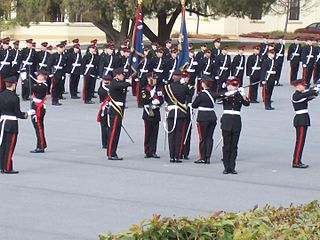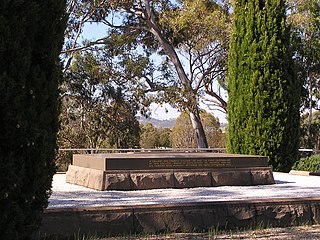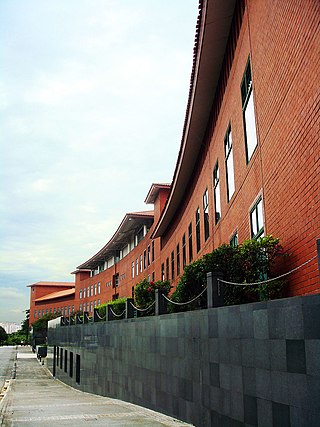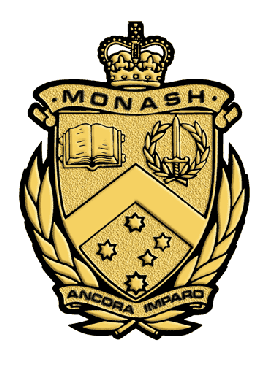
A military academy or service academy is an educational institution which prepares candidates for service in the officer corps. It normally provides education in a military environment, the exact definition depending on the country concerned.
Second lieutenant is a junior commissioned officer military rank in many armed forces.
An officer candidate school (OCS) is a military school which trains civilians and enlisted personnel in order for them to gain a commission as officers in the armed forces of a country. How OCS is run differs between countries and services. Typically, officer candidates have already attained post-secondary education, and sometimes a bachelor's degree, and undergo a short duration of training which focuses primarily on military skills and leadership. This is in contrast with a military academy which includes academic instruction leading to a bachelor's degree.

Major General Sir William Throsby Bridges, was a senior Australian Army officer who was instrumental in establishing the Royal Military College, Duntroon and who served as the first Australian Chief of the General Staff. During the First World War he commanded the 1st Australian Division at Gallipoli, where he died of wounds on 18 May 1915, becoming the first Australian general officer to be killed during the war. He was the first Australian officer—and the first graduate of Kingston—to reach the rank of major general, the first to command a division, and the first to receive a knighthood. He is one of only two Australians killed in action in the Great War to be interred in Australia.

The Royal Military College, Duntroon, also known simply as Duntroon, is the Australian Army's officer training establishment. It was founded at Duntroon, in Canberra, Australian Capital Territory, in 1911 and is at the foot of Mount Pleasant near Lake Burley Griffin, close to the Department of Defence headquarters at Russell Hill. It is comparable to the United Kingdom's Royal Military Academy Sandhurst and the United States Military Academy at West Point. Duntroon is adjacent to the Australian Defence Force Academy (ADFA), which is Australian Defence Force's tri-service military academy that provides military and tertiary academic education for junior officers of the Australian Army, Royal Australian Air Force and the Royal Australian Navy.
Officer Cadet is a rank held by military cadets during their training to become commissioned officers. In the United Kingdom, the rank is also used by members of University Royal Naval Units, University Officer Training Corps and University Air Squadron; however, these are not trainee officers with many not choosing a career in the armed forces.

Peter John Badcoe, was an Australian recipient of the Victoria Cross, the highest award for gallantry in battle that could be awarded at that time to a member of the Australian armed forces. Badcoe, born Peter Badcock, joined the Australian Army in 1950 and graduated from the Officer Cadet School, Portsea, in 1952 as a second lieutenant in the Royal Australian Artillery. A series of regimental postings followed, including a tour in the Federation of Malaya in 1962, during which he spent a week in South Vietnam observing the fighting. During the previous year, Badcock had changed his surname to Badcoe. After another regimental posting, he transferred to the Royal Australian Infantry Corps, and was promoted to major.

Point Nepean marks the southern point of The Rip and the most westerly point of the Mornington Peninsula, in Victoria, Australia. It was named in 1802 after the British politician and colonial administrator Sir Evan Nepean by John Murray in HMS Lady Nelson. Its coast and adjacent waters are included in the Port Phillip Heads Marine National Park, while its land area is part of the Point Nepean National Park. The point includes Cheviot Beach on its southern side, notable as the site of the disappearance in 1967 of Australia's then-Prime Minister Harold Holt.

General Sir Phillip Harvey Bennett, is a retired senior officer of the Australian Army who served as Chief of the Australian Defence Force from 1984 to 1987, and later as Governor of Tasmania from 1987 to 1995.
Australian Army officers receive a commission from the Governor-General of Australia, who is also the Commander-in-Chief of the Australian Defence Force. The commission is signed by both the Governor-General and the Minister of Defence. Rank insignia for commissioned officers is identical to that of the British Army, with the addition of a band containing the word "Australia" beneath the insignia.

The Australian Defence Force Academy (ADFA) is a tri-service military Academy that provides military and academic education for junior officers of the Australian Defence Force in the Royal Australian Navy (RAN), Australian Army and Royal Australian Air Force (RAAF). In 2016 the Academy began accepting civilian students in its undergraduate courses.

The Officer Cadet School (OCS) is a military training centre that trains commissioned officers for the four branches of the Singapore Armed Forces (SAF): the Army, the Navy, the Air Force, and the Digital and Intelligence Service. Located within the SAFTI Military Institute complex in Jurong West, it has twelve wings inclusive of tri-service wings. Nine wings are named according to the NATO phonetic alphabet from A (Alpha) to E (Echo) and S (Sierra) and T (Tango), while the remaining three wings are for the Navy, Air Force, and Digital and Intelligence Service, respectively. The trainees are mostly drawn from the best performing recruits in each basic military training cohort. Trainees with outstanding performance from the Specialist Cadet School (SCS), where specialists are trained, are also invited to transfer to OCS. Career soldiers may also attend OCS on application, recommendation and selection. OCS trainees are known as Officer Cadets (OCTs) if they serve in the Army and Air Force, Midshipmen (MIDs) if they serve in the Navy, and Senior Military Expert Trainees (ME4Ts) if they serve in the Digital and Intelligence Service.

The Monash University Regiment was an officer training regiment of the Australian Army, based in Victoria near Monash University. It was a direct command training unit of the 4th Brigade, and part of the 2nd Division, it was responsible for training of ARes officer cadets (OCDTs) for graduation as lieutenants, and provided driver training and promotion courses for junior non commissioned officers.
The Officer Training Unit, Scheyville was a military training establishment for officers of the Australian Army. Located in the area of Scheyville in the Hawkesbury region of Sydney, Australia, the establishment was opened in April 1965 to train officer cadets who had been called up for service under the national service scheme and offered a short but rigorous commissioning course for trainees, tailored to meet the Army's need to increase the number of junior officers being produced in order to meet commitments to train national servicemen, and to provide platoon commanders for units serving overseas in Vietnam and other parts of Southeast Asia. It was closed in 1974 after the national service scheme was abolished in December 1972 and the last OCS Portsea class finished their time at Scheyville.
Lieutenant General Francis John "Frank" Hickling is a retired senior Australian Army officer, whose career culminated with his appointment as Chief of Army from 1998 to 2000.

Major General Ronald Nicholas Lamond Hopkins CBE was a senior officer in the Australian Army. He began his military career in 1915 when he entered the Royal Military College, Duntroon as a staff cadet and graduated as a lieutenant in the Permanent Forces in late 1917. Following this, he was deployed overseas and subsequently served in the Sinai and Palestine Campaign during the First World War. During the inter war years, Hopkins undertook a variety of regimental and staff positions in Australia, India and the United Kingdom. During the Second World War, he was promoted several times, briefly commanding the 7th Division Cavalry Regiment and was deployed to the Middle East before returning to Australia to undertook further staff positions. In this role he played a key role in organising the Australian Armoured Corps before later serving as a liaison officer to American forces taking part in the New Guinea campaign. Following the war, Hopkins commanded the 34th Brigade in Japan, before finishing his career as Commandant of the Royal Military College, Duntroon. In retirement he wrote a comprehensive history of the Royal Australian Armoured Corps before he died in 1990 at the age of 93.

Malcolm Stuart Kennedy was an Australian rules footballer who played with Melbourne in the Victorian Football League (VFL). He was killed in action on active service in Belgium in World War I.
The Women's Royal Australian Army Corps (WRAAC) was formed as an all women's corps of the Australian Army in April 1951. Its Colonel-in-Chief was Princess Margaret, Countess of Snowdon. The purpose of the corps was to counter a personnel shortage that developed due to fighting during the Korean War and post-World War II full employment. At the time of its formation, many senior WRAAC personnel had previously served in the Australian Women's Army Service (AWAS), which had been raised during World War II, and as a result the WRAAC is considered to have its origins in the AWAS. The corps consisted of both Regular and part-time personnel, and had commissioned officers, warrant officers, non commissioned officers and other ranks who filled a variety of roles including general duties, cooking, clerical work, instruction, warehousing, and signalling. There were also librarians, coders, projectionists, and psychologists.
Major General Jeffery John Sengelman, is a retired senior officer of the Australian Army. He joined the army via the Officer Cadet School, Portsea in 1980, was commissioned into the Royal Australian Infantry Corps and spent much of his military career in special forces. He commanded the 4th Battalion, Royal Australian Regiment (Commando) (2000–01) and the 6th Brigade (2010–11), deployed on operations to East Timor and Iraq, and served as Commander Forces Command in 2011, Deputy Chief of Army from 2011 to 2012, Head of Modernisation and Strategic Planning – Army from 2012 to 2014, and Special Operations Commander Australia from 2014 until his retirement in 2017.
Brigadier Eric Lacy Vowles, was an Australian soldier who served during the First World War and Second World War.











